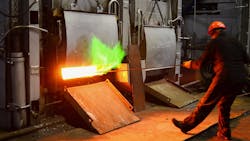This article was updated Jan. 18, 2023. It was originally published Aug. 20, 2016.
RELATED
Carbonitriding Identified and Fixed in Heat-Treatment Problem
Diodes Reduce Stress in 3D-printed Metal Parts
Do We Outsource Induction Heat Treating?
How to Determine the Best Heat Treatment for Your Parts
It wasn’t long after humans discovered metals that they also discovered ways to apply heat to them to change their properties, such as making the metal stronger or more flexible. Here are some concise explanations of various heat-treating processes metalworkers rely on to ensure the metals they turn out have the properties customers need.
Annealing. Heating and slowly cooling metal (usually steel) to remove stresses makes the metal softer or changes its ductility.
Carburizing. Adding carbon to the surface of an iron alloy part by heating it to below the alloy’s melting point (usually between 1,560°F and 1,740°F), then putting it in contact with carbon-rich solids, liquids, or gasses. This increases the metal’s strength and makes the part’s surface harder and more abrasion-resistant, but it also decreases the metal’s toughness. Carburizing is usually done on finished parts.
Case hardening. Hardening an iron alloy part by carburizing it and then quenching it to fix the changes made in the alloy’s structure. This makes the center of the part relatively soft. Thus, the part consists of a hardened case around a soft core.
Cyanide hardening. A variant on case hardening, this process brings a part’s metal surface in contact with molten cyanide salt. The part is then quenched.
Decarburization. Removes carbon from the surface of steel by applying heat or through the normal aging process of oxidation.
Drawing (tempering). Metal is reheated after being hardened, then held at a specific temperature, and finally quenched. This reduces hardness and increases toughness.
Nitriding. This hardening process adds nitrogen to the metal surface through contact with ammonia gas. It produces case hardened parts without quenching.
Precipitation hardening. This process (also known as age hardening) holds the metal part at an elevated temperatures without quenching. This increases the yield strength of malleable materials, including most alloys of aluminum, magnesium, nickel, titanium, and some stainless steels . In superalloys, it can improve high-temperature strength.
Quenching. Steel or other metal is rapidly cooled by immersing it into oil or water, fixing its structure in a hardened state. Quenching is often the final step in hardening processes.
Sphereoidizing. This describes any process of heating and cooling steel for to increasing the amount of rounded or globular carbide in the metal. It softens the steel and improves its ductility.
Cold working. While not a heat-treating process, it does change a metal’s characteristics. It entails deforming the metal at room temperature without fracturing it. This changes its shape, giving the metal more tensile strength and better machinability.
David Zimmermann was president of Pivot Point Inc., Hustiford, Wis., when this material first appeared.
